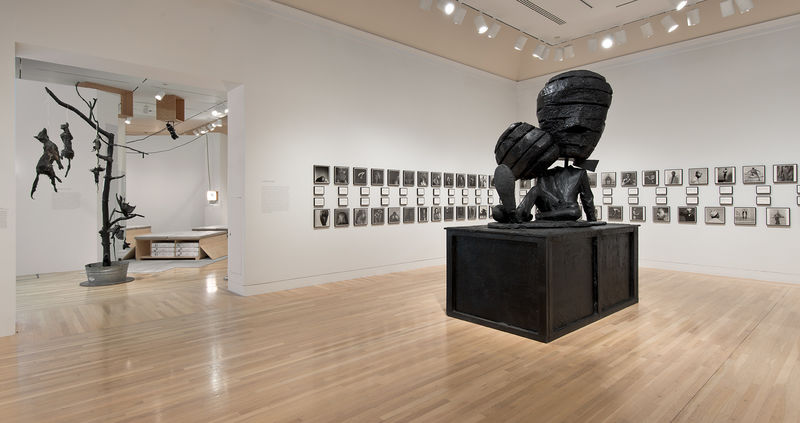
Paul McCarthy
During his years studying art and film in graduate school at the University of Southern California in Los Angeles in the early 1970s and throughout the 1970s and 1980s, Paul McCarthy made seminal performances and single-channel videos that frequently mined, with increasingly abject flourishes, the relationship of the body to architectural space. These early works can now be seen as foundational to his current monumental sculptures and installations and his elaborate narrative videos. Taking on familiar roles from international popular culture or embodying character types (chef, cowboy, painter, or soldier, for instance), McCarthy explored the shady undercurrents of media imagery. To varying degrees, these early works engaged a form of media critique that implicated the body as a site for indoctrination and manipulation.
Subjective Subliminal Ads, The Dickies, and Winston Longs (Collage) (all 1976–79) are a parallel group of works on paper that directly appropriate magazine advertisements whose images suggest hidden body parts or that employ provocative coded language or images that blatantly objectify bodies for the purpose of selling products. These "subliminal ads" are designed to produce a generalized desire in the subconscious that will then translate into a specific desire—a desire for the advertised product—in the viewer's conscious mind, a strategy so obvious and ridiculous that McCarthy need only point to it to underscore our culture's susceptibility to such tactics. Of the three works, only Winston Longs (Collage) is the product of any alteration or manipulation by the artist. Beginning as a collection of more than one hundred magazine pages saved by McCarthy for what he calls their "subjective subliminal" content, these works are the only remaining pages of the original archive.#
A later work by McCarthy, Documents Flicker (1995–99), similarly employs found imagery but to dizzying effect. Although he also created a static version of this work consisting of eight large panels covered in images, the "flicker" version takes the form of single-channel video in which an archive of images—from babies to Mickey Mouse, from resort hotels and the Eiffel Tower to a Nazi gathering—takes the viewer on a surreal journey, the pictures flashing by so quickly as to seem like an unconscious dreamscape.

Both darkly humorous and exuberantly satirical, McCarthy's Static (Black) (2004–9) is an uncompromising depiction of blind greed and oblivion. Portraying George W. Bush as a gigantic bobblehead grafted onto a sculpted figure based on McCarthy's own body, the sculpture depicts the former president as empty-eyed and slack-jawed as he fornicates with an enormous pig shod in men's dress shoes. A smaller pig mounts the side of the larger pig's head—creating an unlikely ménage à trois—and the crate-like pedestal is covered in pig parts and other debris. The mindless debauchery of the scene is nauseating in its poignancy today, as the United States struggles to recover from the devastating political and economic consequences of Bush's leadership. Because the sculpture is rendered in monochromatic black (other editions of the work have featured a fleshy monochromatic pink rubber), it momentarily reads as minimal or abstract, but the forms soon become legible. As with most of McCarthy's work, Static (Black) derives its unsettling power from this layering of references that draw us in and implicate us in the work.
—Corrina Peipon


